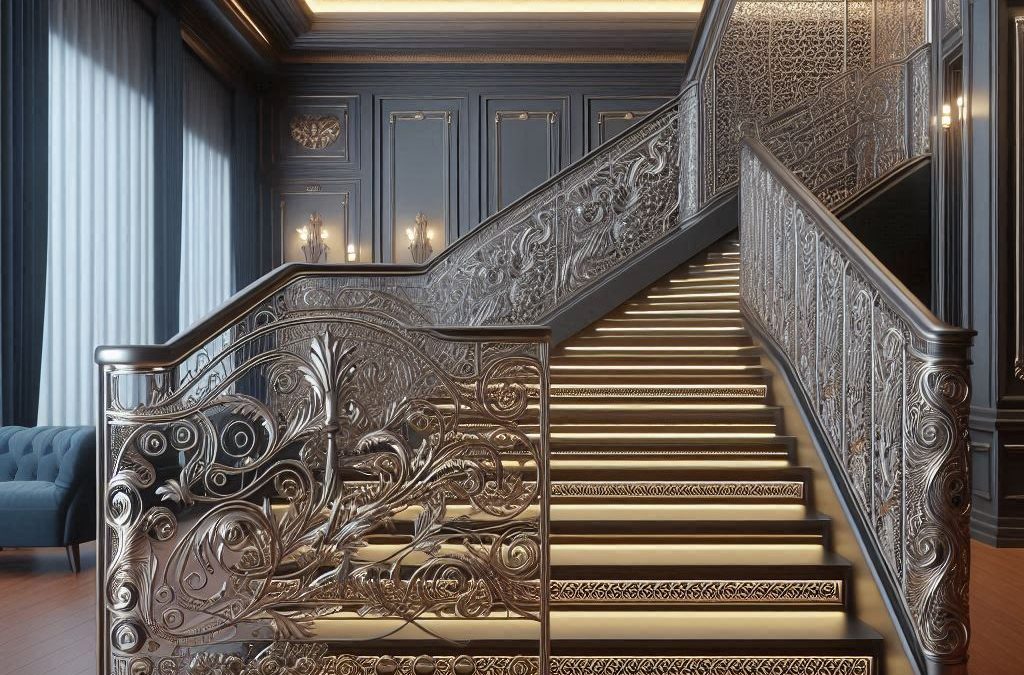
Al-Madina Laser Cutting: Pioneering Laser Cutting Services in Pakistan
July 31, 2024
Why Choose Laser-Cut Stair Railings for Your Home or Business
August 1, 2024The Art and Technology of Stair Railing Laser Cutting
In the world of interior design and architecture, the details make all the difference. One such detail that can significantly enhance the aesthetic and functionality of a space is the stair railing. While traditional methods of crafting stair railings have their merits, modern technology has introduced a new level of precision and creativity: laser cutting.
What is Laser Cutting?
Laser cutting is a technology that uses a laser to cut materials with high precision. In the context of metal fabrication, it involves directing a high-power laser through optics to cut, engrave, or etch metal surfaces. This method offers unparalleled accuracy, allowing for intricate designs and clean cuts that are difficult to achieve with conventional cutting methods.
Benefits of Laser-Cut Stair Railings
- Precision and Accuracy: Laser cutting technology ensures that each cut is precise, resulting in a flawless finish. This precision allows for the creation of complex patterns and designs that add a unique touch to stair railings.
- Customization: With laser cutting, the possibilities for customization are virtually limitless. Homeowners and designers can create bespoke designs that reflect personal style and complement the overall decor of the space.
- Durability: Metal stair railings produced through laser cutting are not only aesthetically pleasing but also incredibly durable. The process strengthens the metal, making it resistant to wear and tear, and ensuring a long-lasting installation.
- Efficiency: Laser cutting is a highly efficient process. It reduces the time required to produce complex designs and minimizes material waste, making it a cost-effective solution for both manufacturers and customers.
- Safety: Stair railings are an essential safety feature in any multi-level building. Laser-cut railings are not only sturdy but also can be designed to meet specific safety standards, providing both security and style.
The Process of Laser Cutting Stair Railings
- Design Phase: The process begins with a design, which can be created using CAD (Computer-Aided Design) software. This digital blueprint is then fed into the laser cutting machine.
- Material Selection: Metal sheets, such as stainless steel, aluminum, or iron, are selected based on the desired finish and strength requirements.
- Cutting: The laser cutting machine uses a focused beam of light to cut through the metal according to the design. The machine’s precision ensures that even the most intricate patterns are executed perfectly.
- Finishing: After cutting, the metal pieces may undergo additional finishing processes such as polishing, painting, or coating to enhance their appearance and durability.
Applications of Laser-Cut Stair Railings
Laser-cut stair railings are versatile and can be used in various settings, including:
- Residential Homes: Custom designs that match the home’s interior decor.
- Commercial Buildings: Durable and stylish railings for offices, hotels, and public spaces.
- Outdoor Installations: Weather-resistant metal railings for outdoor stairs and balconies.
FAQs
Q: What materials can be used for laser-cut stair railings?
A: Common materials include stainless steel, aluminum, and iron, chosen for their strength and aesthetic qualities.
Q: Can laser-cut stair railings be customized?
A: Yes, laser cutting allows for extensive customization, enabling unique designs tailored to individual preferences.
Q: Are laser-cut stair railings durable?
A: Absolutely. The laser cutting process not only allows for precise designs but also enhances the durability of the metal.
Q: How long does it take to produce a laser-cut stair railing?
A: The production time can vary based on the complexity of the design and the size of the project, but laser cutting is generally faster than traditional methods.
Q: Is laser cutting environmentally friendly?
A: Laser cutting is an efficient process that minimizes material waste, making it more environmentally friendly compared to some traditional cutting methods.



